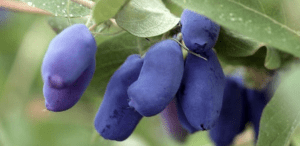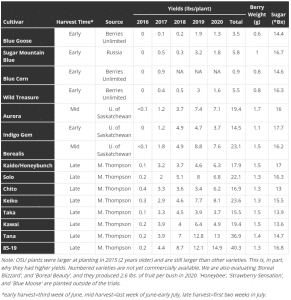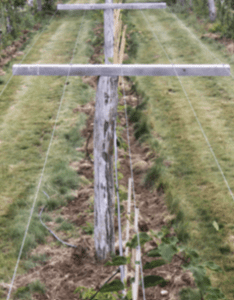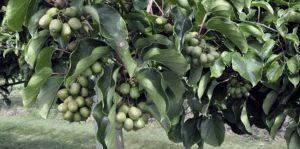Unique Fruit Crops for Farm Diversification
Author: Evan Lentz
Evan.Lentz@uconn.edu
Reviewers: Mary Concklin & Shuresh Ghimire, UConn Extension
Publication EXT107 | March 2025
As climate-related production challenges continue to become more prominent, the need to develop and maintain whole farm resiliency grows. Highly diversified farms enjoy a great deal of innate resiliency, simply due to their mix of commodities. This process of hedging bets allows for a greater degree of freedom when it comes to marketing and ensures flexibility when enduring pest, climate, or other production related challenges.
Diversification can take many forms: utilizing new varieties, expanding into a new commodity group, or employing a new production system. Each requires its own unique level of investment. One unique opportunity for diversification is to explore alternative, novel, or niche fruit crops. Below is a deeper look at two of the most appealing contenders for diversification.
Haskap – Lonicera caerulea

Haskaps, also known as Honeyberries, are a small bush-type honeysuckle native to regions of North America, with small blue elongated fruit and a flavor described as a combination between a raspberry and blueberry. This crop is slowly gaining traction in the region. Haskaps are hardy to Zone 1, are tolerant of most soils, and can be grown in partial sun with the understanding that there will be reduced fruit production. They are even well suited to urban environments.
Plugs/whips should be planted at least three feet apart. Soils should be kept moist, and competition should be kept to a minimum in the first few years. Even grass within three feet of plants can impact establishment. Mulching around young plants can help with weed and moisture management. Supplemental irrigation--about one inch per week--can help to establish plants. Once mature, not as much water will be required. Compost is recommended, especially for young plants, as haskaps have a relatively low nutrient requirement, and are quick to take up nutrients from the soil. The recommended pH range of this crop is from 5.0-8.0.
Flowering occurs in May with harvest following in June/July. Haskaps are self-incompatible so more than one variety is needed.
Below are the results from a haskap variety evaluation done at the University of Montana. Table 1 highlights some of the available varieties, where they were sourced, their relative yields across five years, fruit size, and sugar content.
For more information, visit:
University of Saskatchewan, University of Montana Extension, or Penn State Extension

Kiwiberry – Actinidia arguta

Kiwiberry, also known as Hardy Kiwi, is a woody climbing vine that produces small hairless fruits with a taste like a mild, less acidic kiwi. This crop is also slowly gaining traction, with some Connecticut farmers having already participated in variety trials.
As its name suggests, Hardy Kiwi is cold hardy down to about -25°F, unlike their larger, hairy counterparts. This makes them an ideal candidate for production in our region. However, this crop is still sensitive to low spring temperatures. Kiwiberry is a diecious crop, meaning that growers will need a mix of male and female plants to set fruit (a ratio of 1 male to 6-8 females is recommended) and should expect fruit production on female plants only.
This crop requires well-drained soils, full sun exposure, a soil pH range of 5.5-6.5, and irrigation for at least the first four years. Due to its vining habit, a support system will be required. The recommendation is to utilize a T-bar trellis (Figure 3). Although initial costs may be high, newly planted vineyards can expect to be productive for 20-30 years.
For more information on this crop, check out the online production guide or these Extension websites: NC State, OSU, and UNH Breeding Program.
The information in this document is for educational purposes only. The recommendations contained are based on the best available knowledge at the time of publication. Any reference to commercial products, trade or brand names is for information only, and no endorsement or approval is intended. UConn Extension does not guarantee or warrant the standard of any product referenced or imply approval of the product to the exclusion of others which also may be available. The University of Connecticut, UConn Extension, College of Agriculture, Health and Natural Resources is an equal opportunity program provider and employer.
